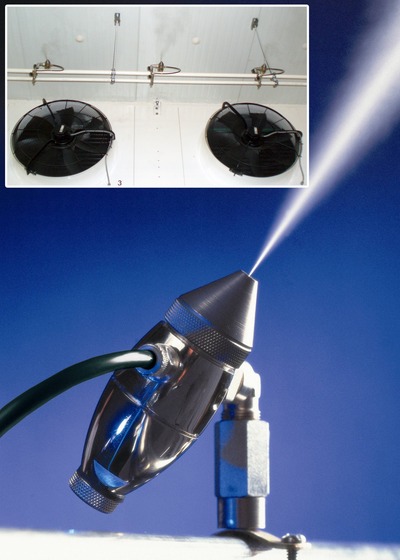Humidity reduces carcass weight loss
Wednesday, 19 June, 2013
Simply increasing humidity in an abattoir chill-down area can reduce carcass moisture loss from 2.5% to less than 1%. Abattoir equipment specialist GM Steel has found that using the JetSpray humidifier from JS Humidifiers reduces carcass moisture loss after slaughter.
“A carcass coming from the slaughter line is wet and warm,” said Robert Ten Cate, consultant at GM Steel. “When it is introduced to the chill store, the cold dry air strips moisture from its exposed surface. The amount depends on the abattoir’s cooling technology but it can be anywhere between 1.2-2.5% of its total weight, and sometimes even more.

“By maintaining a high humidity in the chill store with a JetSpray humidifier during the initial cooling, moisture loss from the carcass is inhibited and can be reduced to less than 1%.”
With the average cost of beef at $4/kg, an abattoir processing 3500 carcasses a week could increase profits by more than $2 million each year by preventing 500,000 kg of beef weight evaporating into the chill store atmosphere.
The JetSpray humidifier comprises rows of precision-engineered nozzles combining compressed air and water to produce a spray with a droplet size of just 7.5 microns. When mounted directly in front of the evaporator coils of the refrigeration system, the nozzle line introduces moisture to the airstream as it enters the chill store. The spray is so fine that the moisture is absorbed by the atmosphere, preventing wetting inside the room.
Its hygienic design makes it suitable for use in food processing facilities. A reverse osmosis water filter removes all minerals from the supply water before it is treated with ultraviolet sterilisation to kill any remaining microorganisms. In addition, the system regularly runs purge and flush cycles to ensure water cannot stagnate in the humidifier.
“Independent testing has shown that by maintaining the optimum humidity during cooling, carcass weight loss is reduced without any condensation forming inside the chill store or on the meat. Humidification of the air does not introduce moisture to the surface of the carcass or increase microbial growth,” said Ten Cate.
“In fact, client tests showed that the high humidity actually reduced microbial growth rather than promote it. The higher humidity improved the conductivity of the air and consequently increased heat transfer from the carcass. Some installations have seen a significant reduction of their chill cycle to reach the required carcass core temperature. As the carcass temperature is reduced more rapidly the microbial growth is inhibited.
“Another significant benefit of a quicker cooling cycle is the reduction in energy consumption of the cooling system. Clients have seen energy bills reduced by as much as 10% when maintaining an optimum humidity in the chill-down area due to improved heat transfer efficiency from the carcasses.”
Blending operations boosted using rotary batch mixer
A contract manufacturer began blending dietary supplement and food powders and manufacturing...
Butter maker required sanitary measurement solution
NOSHOK developed a custom solution for a large butter processing manufacturer which included tank...
Bottle-filling physics: keeping it calm to prevent sloshing
Beverage sloshing at high filling capacities causes loss and soiling — for a better filling...













